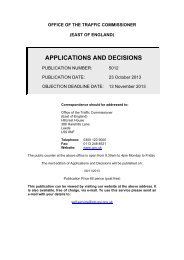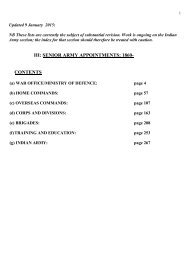2001_000
2001_000
2001_000
You also want an ePaper? Increase the reach of your titles
YUMPU automatically turns print PDFs into web optimized ePapers that Google loves.
University of Leicester Archaeological Services<br />
Evidence for other mortar floors and a wall, since robbed<br />
of its stone, were also found within the trench.<br />
The two trenches in the middle of the site revealed wellpreserved<br />
medieval and Roman levels at a depth of around<br />
1m from the present ground surface. The excavation of<br />
medieval pits and part of a well exposed further evidence<br />
of the robbed walls<br />
and clay floor of a<br />
Roman building.<br />
Two small handexcavated<br />
trenches to<br />
the south-east<br />
provided evidence for<br />
post-medieval and<br />
medieval buildings.<br />
These would have<br />
fronted on to<br />
Highcross Street, and<br />
pre-dated those that<br />
were demolished in<br />
the mid-twentieth<br />
century, prior to the<br />
construction of<br />
Vaughan Way.<br />
The trench in the southern part of the site produced part of<br />
a substantial stone wall, with 0.5m deep footings, in its<br />
northern end. The wall was aligned close to east-west. A<br />
parallel wall, 2.8m to the south, was also seen surviving<br />
beneath the brick floor of the modern cellar. The top of this<br />
wall was level and suggests that it was a base for a<br />
‘stylobate’ – a horizontal course of stone blocks onto which<br />
columns would have been stood to form a colonnade. These<br />
walls may be part of the substantial stone structure seen<br />
during the Blue Boar Lane excavations to the south of the<br />
site in 1958.<br />
The evaluation has shown that particularly well-preserved<br />
archaeological remains exist within the area, close to the<br />
present ground surface. They may also survive beneath<br />
some of the modern cellar floors. At least two substantial<br />
Roman buildings were revealed. To the north, a room with<br />
a hypocaust (central heating system) and fine quality<br />
patterned mosaic floor, next to a corridor with rooms leading<br />
off it, was found,<br />
suggesting the<br />
presence of a high<br />
status town house.<br />
To the south, on the<br />
other side of a<br />
Roman street, lay a<br />
substantial stone built<br />
building, which may<br />
have been the town’s<br />
market hall – a large<br />
public building known<br />
as the macellum.<br />
Above: a glimpse of a fine patterned mosaic<br />
floor below a collapsed Roman building.<br />
During the medieval<br />
period it is likely<br />
that this area was<br />
mainly gardens or<br />
agricultural land, with<br />
buildings only on the frontage of Highcross Street and Friars<br />
Causeway, thus little structural evidence from the medieval<br />
period was revealed in the majority of the site area.<br />
We would like to thank Westmoreland Properties both for<br />
their help and co-operation, and for funding this project.<br />
7





